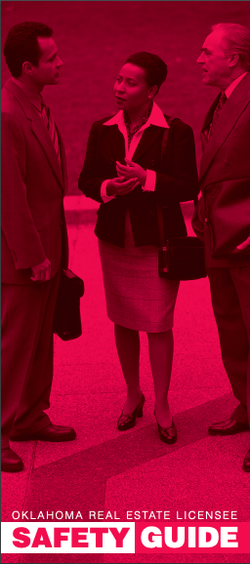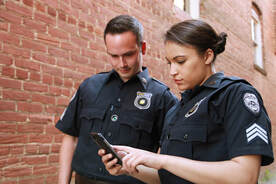CLIENT IDENTIFICATION REQUIREMENTS
TO OUR CLIENTS: We know you are eager to get out and look at new properties. Please understand that the request for identification and financial proof of ability to purchase is a matter of safety. If your agent has asked for this, please know it is required by the brokerage and is NOT negotiable.
INDEPENDENT CONTRACTOR SAFETY INFORMATION
|
As an independent contractor, your broker has little say over one of the most important aspects of your career: your safety.
Realtors are often the target of scammers and other people with illicit intent. Whether it's simple robbery or worse, you're in charge of knowing how to protect yourself. Smart Move has provided the following resources that are required from our agents: If you are meeting to show for the first time please also copy your broker in on your showing itinerary within ShowingTime. |
SAFETY RESOURCES

There are so many safety resources out there for Realtors, but you must stop and take the time to read and implement the practices in your own business. Our own Oklahoma Real Estate Commission has published a excellent Realtor Safety Guide, parts of which are excerpted below.
First-time meeting with clients
All agents must arrange to meet prospects and clients whom they have never met at a public place, rather than at properties, out of doors, or at home.
Client IDs
All first-time clients must provide a driver’s license, state ID or other official photo ID. Make and retain a copy of this ID for security purposes, text or e-mail a copy to the office.
Distress code system
All employees, including officer personnel, will be educated on a single “distress code” to be used by agents calling in if they feel threatened.
Buddy system
Agents who are uncomfortable meeting with clients alone or hosting open houses alone can request a “buddy” agent or employee to go with them.
First-time meeting with clients
All agents must arrange to meet prospects and clients whom they have never met at a public place, rather than at properties, out of doors, or at home.
Client IDs
All first-time clients must provide a driver’s license, state ID or other official photo ID. Make and retain a copy of this ID for security purposes, text or e-mail a copy to the office.
Distress code system
All employees, including officer personnel, will be educated on a single “distress code” to be used by agents calling in if they feel threatened.
Buddy system
Agents who are uncomfortable meeting with clients alone or hosting open houses alone can request a “buddy” agent or employee to go with them.
SAFETY TIPS & Additional Resources
NAR has an excellent Realtor Safety Guide, with three separate sections for your perusal and implementation.
Real estate licensees routinely find themselves in situations where they are alone with clients or customers about whom they have very little information. The very nature of showing real estate to prospective buyers and tenants who are virtual strangers can make licensees, both men and women, susceptible to becoming victims of violent crimes.
The following information is excerpted from the Oklahoma Real Estate Licensee Safety Guide:
Summary of Basic Safety Practices
SAFETY TIP #1 – KNOW WHO YOU ARE DEALING WITH WHEN YOU HAVE NEW CLIENTS OR CUSTOMERS
SAFETY TIP #2 – TELL SOMEONE
SAFETY TIP #3 - KEEP A CELL PHONE AT YOUR SIDE
SAFETY TIP #4 – CONDUCT A SAFE OPEN HOUSE
SAFETY TIP #5 – HAVE A DISTRESS CODE
SAFETY TIP #6 – DON’T MAKE PERSONAL MARKETING TOO PERSONAL
SAFETY TIP #7 – HAVE A BUDDY
Know in advance whom you are going to call when:
SAFETY TIP #8 – DRESS FOR SAFETY
SAFETY TIP #9 – TRUST YOUR INSTINCTS ABOUT DANGER
SAFETY TIP #10 – PRACTICE CAR SAFETY
SAFETY TIP #11 – LET THEM LEAD THE WAY
SAFETY TIP #12 – FIGHT OR FLIGHT?
Real estate licensees routinely find themselves in situations where they are alone with clients or customers about whom they have very little information. The very nature of showing real estate to prospective buyers and tenants who are virtual strangers can make licensees, both men and women, susceptible to becoming victims of violent crimes.
The following information is excerpted from the Oklahoma Real Estate Licensee Safety Guide:
Summary of Basic Safety Practices
- Identify the person you are working with before you join him or her alone, in a car or a house. Preferably meet them at your office, copy his or her driver’s license and make sure someone from your office knows where you‘ll be going with the person. No ID, NO HOUSE SHOWINGS. Ask for IDs from every adult who will attend the showing. Then search them on OSCN to reveal Oklahoma court history. There are other avenues, but OSCN is a great start.
- Always carry your cell phone with you and make sure it is fully charged and has reception. Program 911 into speed dial and don’t hesitate to call for help.
- Trust your instincts. If you have a bad feeling, don’t second-guess what it’s telling you. Listen to your gut feeling and protect yourself.
SAFETY TIP #1 – KNOW WHO YOU ARE DEALING WITH WHEN YOU HAVE NEW CLIENTS OR CUSTOMERS
- Meet them in public
- Complete the Client/Customer Identification Form
- Photocopy their driver’s license
- Get their car description and license number
- Verify their identity
SAFETY TIP #2 – TELL SOMEONE
- Who you are with
- Where you are going
- When you will be back
SAFETY TIP #3 - KEEP A CELL PHONE AT YOUR SIDE
- Program your emergency numbers into speed dial. These numbers should include 911, emergency road service, your office, your buddy and your family numbers.
- Keep your cell phone fully charged. SHOWING APPS DRAIN YOUR BATTERY QUICKLY.
- Carry your cell phone with you at all times. Get a holster and make it a part of your apparel, or keep it in your hand at all times. Your greatest source of help is your cell phone. If you keep your cell phone in a purse or briefcase, it may not be available when you need it most.
- It’s a good idea to keep a cell phone charging adapter in your car for emergency situations.
- Create and share a distress signal with people in the office.
- Rehearse in your own mind how you would react to an emergency situation such as a mugging or physical attack. Know when you will fight back, when you will run and when you will have an opportunity to call 911 for assistance.
SAFETY TIP #4 – CONDUCT A SAFE OPEN HOUSE
- Don’t advertise a listing as vacant
- Establish escape routes from each level of the house
- Call your broker or a buddy hourly
- Keep your keys and cell phone with you
- Park where you can get out quickly
SAFETY TIP #5 – HAVE A DISTRESS CODE
- Have a prearranged distress signal: “I’m at the Jones house at (address) and I need the red file right away.”
SAFETY TIP #6 – DON’T MAKE PERSONAL MARKETING TOO PERSONAL
- Your marketing material should be polished and professional.
- Limit the amount of personal information you share.
- Use your cell number, not your home phone number.
- Use your office address rather than your home address.
SAFETY TIP #7 – HAVE A BUDDY
Know in advance whom you are going to call when:
- Your instincts tell you to get help
- You’re just a little nervous
- You need help at an open house
SAFETY TIP #8 – DRESS FOR SAFETY
- Don’t wear expensive jewelry
- Always wear your cell phone
- Dress for the weather
- Only carry the cash or credit cards you need
SAFETY TIP #9 – TRUST YOUR INSTINCTS ABOUT DANGER
- Gut feelings
- Hesitation
- Unexplained fear
- Apprehension
SAFETY TIP #10 – PRACTICE CAR SAFETY
- Always have your keys with you
- Park in a well-lit area
- Keep car doors locked at all times
- Don’t get blocked in
- Beware of dead-end streets
- Keep your car in good running condition
- Consider using separate cars
SAFETY TIP #11 – LET THEM LEAD THE WAY
- Be aware of possible escape routes
- Leave doors open
- Be wary in attics and basements
- Walk behind your clients
SAFETY TIP #12 – FIGHT OR FLIGHT?
- Yell “fire” to get attention
- Select a response that fits the situation
- Run and call 911 when you can
- Take a self-defense training course
- If you strike, mean it

